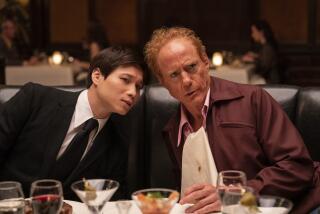HOME ENTERTAINMENT : ‘Platoon’: Stone’s Vietnam Scrapbook
As you open the olive-drab cover of Pioneer’s 3 1/2-pound special laser edition of Oliver Stone’s 1986 “Platoon,” you sense that this really is a special edition.
The scrapbook-like cover sets the tone. Embossed dog tags of the film’s protagonist, Christopher D. Taylor (Charlie Sheen), dangle toward a snapshot of a Vietnam platoon--writer-director Stone’s own unit. The juxtaposition of Stone’s war experience with his dramatization of it deftly symbolizes their intersection.
For once, the hefty price tag ($130) is justified. Unlike some pricey laser “collector’s editions” that offer only a smattering of script material or photos and no supplementary soundtrack, this handsome edition sets a standard that other laser producers should note. It’s clear that this kind of production takes the wholehearted participation of the principals, and “Platoon” certainly has gotten that.
Producer Arnold Koppelson, who entered the picture after virtually every studio in town turned Stone down, provided many production stills. He also shot footage of the arduous production in the Philippines, used for an hour documentary--”A Tour of the Inferno: Revisiting Platoon”--created for this special-edition laser.
Virtually all the actors involved in the film--Sheen, Johnny Depp, Willem Dafoe, Tom Berenger, Forest Whitaker and John McGinley, among them--speak candidly about the filming and how deeply it affected them.
*
While Stone offers a virtual shot-by-shot tour of the film and his memory bank on his two-hour supplementary audio soundtrack, the documentary on Side Four makes a good introduction to the film, whether it’s your first viewing or a return trip.
The madness of the war and the intense filming experience is also well-described by technical adviser Capt. Dale Dye, who also provides an illuminating two-hour audio commentary. He trained his young acting recruits much as he would train real recruits for battle.
And they responded in kind.
“I hope the one thing people walk away with is this film is the truth; this film is about the horrors, the madness,” Sheen says. In a sense, that gave Depp “a hunger and a drive,” he says, to make films that have something to say. “By the end of ‘Platoon,’ we felt we had made a love story about people dying in war,” observes McGinley.
The THX wide screen transfer is dazzling in itself. The “striking use of technology” makes this release “almost an improvement over what was originally shot,” Stone acknowledges. Indeed, the feel and smell of the Vietnam jungle almost permeates the room, with the THX sound providing an overwhelming sonic experience.
The scrapbook presentation provides the actual shooting script along with pre-production drafts; handwritten notes made by Stone during shooting; revisions that survived the final cut, and scenes moved according to the final cut--clearly delineated by different type styles.
The scrapbook includes a 48-page collection of Stone’s Vietnam photos as well as stills taken in the Philippines during production. Storyboards, diagrams and shooting schedules also take up some of the 148 pages.
All in all, an imposing, definitive record of a milestone film that will no doubt be celebrated for more than the four Oscars it earned (including best picture and best director) as its 10-year anniversary draws nearer.
“These boys were returned old and fractured souls,” Stone says of the young recruits who formed his platoon. How and why becomes clear in this carefully put together laser edition, executive produced by Charles Kiselyak.
More to Read
Only good movies
Get the Indie Focus newsletter, Mark Olsen's weekly guide to the world of cinema.
You may occasionally receive promotional content from the Los Angeles Times.










